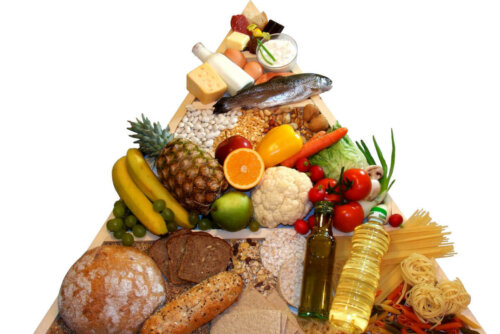Food Groups According to Their Function


Written and verified by the nutritionist Florencia Villafañe
Do you know what the official nutrition food groups are, according to their functions? Without a doubt, the nutrients in foods perform different functions in your body. If you want to know more about this, this article is for you!
Likewise, identifying what substances you ingest daily is a tool that you can use to preserve your health and treat and prevent metabolic diseases, among other benefits. If you understand this, you’ll be able to improve your diet.
What are the food groups?
Each food contains one or more of the following nutrients: carbohydrates, proteins, fats, vitamins, and minerals. In addition, they also contain water, which is vital for the body, in variable amounts.
Thus, certain components predominate over others in some foods, which is why international and national food guidelines have determined the following food groups:
- Milks, yogurts, and cheeses
- Meats and eggs
- Fruits and vegetables
- Oils, nuts, and seeds
- Legumes, cereals, potatoes, bread, and pasta
- Sweets and fats

You should also read: Adopt a Vegetarian Diet without Reducing Nutrients
What are the functions of foods?
Several studies have suggested that the nutrients that make up your diet have energetic, structure forming, and restorative functions. Similarly, they also state that you have to follow a varied diet to achieve an optimal nutritional status. Below, you’ll discover more details about the different food groups.
Foods that provide energy
Energy is the fuel the body needs to live. All metabolic processes require it. In fact, the actions you do on a daily basis, such as walking, moving, and breathing, are a few examples.
It’s clear that you need to eat foods to get energy. Specifically, the foods that provide energy are those that contain carbohydrates, such as legumes, cereals, potatoes, pasta, and sweets. After eating them, your body digests and absorbs them as glucose, which is the main fuel source.
Fats also have this effect, as they supply twice the calories of carbohydrates. In addition, oils, nuts, egg yolk, and seeds are also energetic foods. The latter release their fatty acids when they’re ground or as oils.
Foods that build and maintain body cells
These foods build cellular structures and tissues. Those that have this power contain proteins, such as meats, dairy products, and egg whites.
This nutrient is rich in amino acids, some of which experts consider essential because the body doesn’t produce them. Thus, you must consume them throughout your diet. Besides being indispensable in structural synthesis, they have other functions.
Foods of animal origin are the ones that stand out due to their protein content. However, this doesn’t mean that you can’t get them through vegetables. In fact, there’s scientific evidence that cereals, legumes, and nuts contain this nutrient in significant amounts.
Those who follow a vegan or vegetarian diet can meet their recommended dietary allowance with the help of a professional specialized in this subject.
Tissue formation is a vital process that shouldn’t be neglected. In fact, it requires adequate amounts of nutrients, even in restrictive diets that don’t include foods of animal origin.
Regulatory or protective function

The action of vitamins, minerals, anti-inflammatory substances, and phytochemical compounds (active ingredients that plants produce) determines this function. The foods that contain them are fruits and vegetables.
However, you can also find them in other sources, such as iron in meats and legumes, as well as vitamin A and D in dairy products. Although their recommended dietary allowances are lower in comparison with other nutrients, this doesn’t mean they’re less important.
In short, the substances we mentioned play an important role in the body because they act in different metabolic processes. In this sense, some prevent cell oxidation and repair the skin (vitamin C and E), others integrate tissues (calcium in bones and teeth), and others promote cellular reactions (zinc and magnesium).
What to remember about food groups according to their function
The combination of the different food groups ensures that you’ll get what you need. If you follow a varied and balanced diet rich in proteins, carbohydrates, fats, vitamins, and minerals, you’ll be contributing to your health in general.
In addition to having healthy habits, it’s advisable to avoid toxic substances, such as alcohol and cigarettes. In the same way, an active and non-sedentary life accompanies the processes that the substances in your diet must perform in your body.
All cited sources were thoroughly reviewed by our team to ensure their quality, reliability, currency, and validity. The bibliography of this article was considered reliable and of academic or scientific accuracy.
- Andújar, R. C., & Fincias, L. A. (2009). Nutrición y salud. SEMERGEN-Medicina de familia, 35(9), 443-449.
- Guía alimentaria para la población Argentina. 2017. Ministerio de Salud.
- Rosas, Carlos, and Olimpia Carrillo. “Principales rutas metabólicas, utilización de la energía.” Estado actual y perspectivas de la nutrición de los camarones peneidos cultivados en Iberoamérica. México, DF (2006): 61-88.
- Jiménez, Paula, Lilia Masson, and Vilma Quitral. “Composición química de semillas de chía, linaza y rosa mosqueta y su aporte en ácidos grasos omega-3.” Revista chilena de nutrición 40.2 (2013): 155-160.
- González-Torres, Laura, et al. “Las proteínas en la nutrición.” Revista salud pública y nutrición 8.2 (2007): 1-7.
- Farran, A., M. Illan, and L. Padró. “Dieta vegetariana y otras dietas alternativas.” Pediatría Integral. 5th ed. Sociedad Española de Pediatría Extrahospitalaria y Atención Primaria (SEPEAP) (2015): 313-23.
- Akabas, Sharon R., and Karen R. Dolins. “Micronutrient requirements of physically active women: what can we learn from iron?.” The American journal of clinical nutrition 81.5 (2005): 1246S-1251S.
- Barrera, Eliud S. Aguilar, et al. “Suplementación con magnesio y control metabólico en diabetes. Revisión sistemática de revisiones sistemáticas y metaanálisis.” Revista española de nutrición humana y dietética 23.1 (2019): 144-146.
This text is provided for informational purposes only and does not replace consultation with a professional. If in doubt, consult your specialist.








